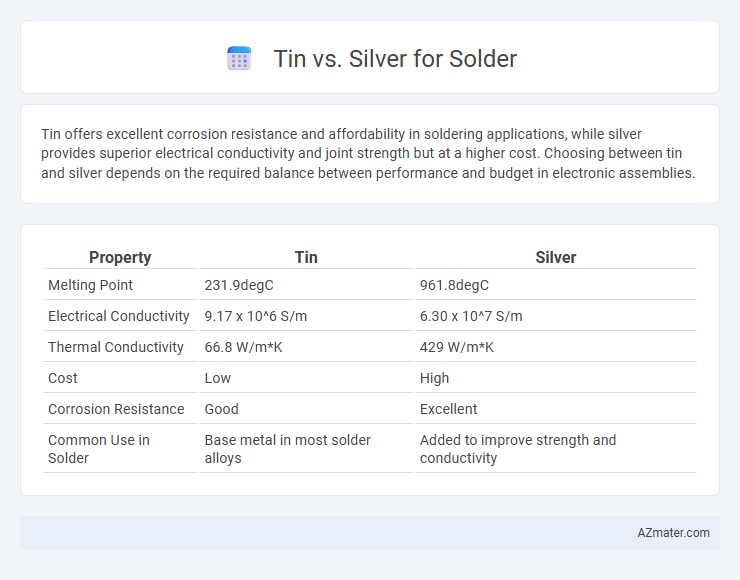Tin offers excellent corrosion resistance and affordability in soldering applications, while silver provides superior electrical conductivity and joint strength but at a higher cost. Choosing between tin and silver depends on the required balance between performance and budget in electronic assemblies.
Table of Comparison
| Property | Tin | Silver |
|---|---|---|
| Melting Point | 231.9degC | 961.8degC |
| Electrical Conductivity | 9.17 x 10^6 S/m | 6.30 x 10^7 S/m |
| Thermal Conductivity | 66.8 W/m*K | 429 W/m*K |
| Cost | Low | High |
| Corrosion Resistance | Good | Excellent |
| Common Use in Solder | Base metal in most solder alloys | Added to improve strength and conductivity |
Introduction: The Importance of Solder Choice
Selecting the appropriate solder, such as tin or silver-based alloys, critically influences electrical conductivity, mechanical strength, and corrosion resistance in electronic assemblies. Tin solder, predominantly tin-lead or lead-free tin-copper blends, offers excellent wettability and cost efficiency, making it a staple in various manufacturing processes. Silver solder, containing higher silver content, provides superior thermal fatigue resistance and enhanced joint reliability, essential for high-performance and high-temperature applications.
Composition of Tin and Silver Solders
Tin and silver solders differ primarily in their composition, with tin solder typically consisting of about 60-63% tin and the remainder mostly lead or copper, while silver solder contains approximately 40-60% silver combined with copper and zinc. The high silver content in silver solder enhances its melting point, tensile strength, and corrosion resistance compared to tin-based solders. These compositional differences influence their application suitability, with tin solder favored for electronics due to lower melting temperatures and silver solder preferred in plumbing and jewelry for durability and aesthetic finish.
Melting Points: Tin vs Silver
Tin melts at approximately 232degC, making it a popular solder material due to its relatively low melting point that allows for easy and safe joining of electronic components. Silver, with a melting point around 961.8degC, is significantly higher, providing superior mechanical strength and thermal conductivity in solder alloys but requiring higher temperatures and specialized equipment for soldering. The choice between tin and silver solder depends on the specific thermal and mechanical demands of the application, with tin offering ease of use and silver delivering enhanced durability and thermal performance.
Electrical Conductivity Comparison
Silver solder offers higher electrical conductivity, approximately 63 MS/m, compared to tin solder's typical conductivity of around 9 MS/m, making silver ideal for high-performance electronic connections. Tin solder, often alloyed with lead or other metals, provides adequate conductivity while maintaining cost-effectiveness and ease of use in general electronics. Choosing silver solder improves signal integrity in sensitive circuits due to its superior electron flow capability, especially in high-frequency or power applications.
Mechanical Strength and Durability
Tin-silver solder alloys exhibit superior mechanical strength compared to pure tin, providing enhanced joint robustness in electronic assemblies. The addition of silver increases the durability of solder joints by improving resistance to thermal fatigue and mechanical shock. These properties make tin-silver solder ideal for applications requiring long-lasting and reliable mechanical performance under stress.
Corrosion Resistance and Longevity
Silver solder offers superior corrosion resistance compared to tin solder, making it ideal for applications exposed to harsh environments. Tin solder tends to oxidize and corrode faster, reducing joint durability and overall longevity. The enhanced mechanical strength and corrosion resistance of silver solder contribute to longer-lasting, more reliable electronic and plumbing connections.
Application Suitability: Electronics, Plumbing, and More
Tin-based solder, especially with lead-free alloys containing silver or copper, is highly suitable for electronics due to its excellent electrical conductivity and low melting point, ensuring reliable PCB connections. Silver solder, often used in plumbing and jewelry making, offers superior mechanical strength and higher melting temperatures, making it ideal for metal joints subjected to thermal stress and pressure. Tin solder excels in delicate electronic assemblies, while silver solder provides durability and corrosion resistance necessary for plumbing and heavy-duty metalwork applications.
Health and Environmental Considerations
Tin solder typically offers lower toxicity compared to silver-based solder, reducing health risks during handling and soldering processes. Silver solder contains higher amounts of heavy metals, which can pose environmental hazards if not properly disposed of, increasing contamination risks. Choosing tin solder helps minimize exposure to harmful substances and supports safer waste management practices in electronics manufacturing.
Cost Analysis: Tin Solder vs Silver Solder
Tin solder offers a significantly lower material cost compared to silver solder, making it the preferred choice for budget-conscious electronics manufacturing. Silver solder contains a higher percentage of precious metals, which drives up its price and is typically reserved for specialized applications requiring superior electrical conductivity and mechanical strength. Evaluating total cost should include not only raw material expenses but also factors such as joint reliability and potential rework costs associated with the specific solder type.
Final Recommendation: Choosing the Right Solder
Tin-based solder offers excellent wettability and mechanical strength, making it ideal for most electronic applications, while silver solder provides superior thermal conductivity and corrosion resistance, suited for high-performance or specialized tasks. The final recommendation depends on project requirements: use tin solder for general electronics due to its cost-effectiveness and ease of use, and select silver solder when durability and thermal performance are critical. Prioritizing compatibility with components and operating conditions ensures reliable, long-lasting solder joints.

Infographic: Tin vs Silver for Solder
 azmater.com
azmater.com